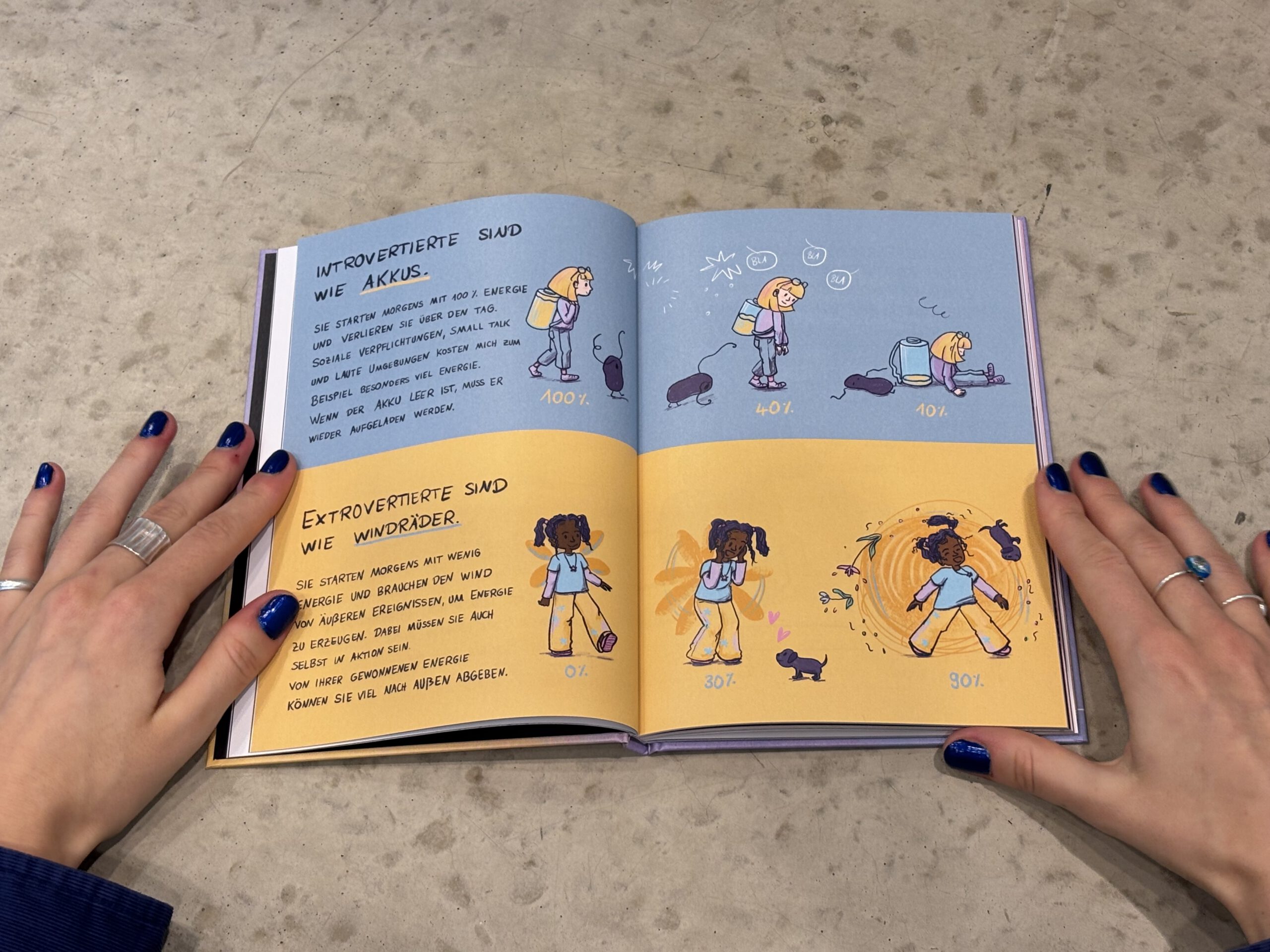HSBI student Carina Thomas from the Department of Design has published a comic non-fiction book on the subject of ‘introversion’. In ‘Say something’, she uses her own illustrations and texts to sketch what it is like to grow up as an introverted child. The book, which is also her bachelor’s thesis, has now been published by CalmeMara Verlag.
Bielefeld/Germany (hsbi), March 10, 2025. A little blonde girl with glasses at a birthday party. She sits there happily and listens to the conversations. Suddenly she is torn from her thoughts by a loud voice: ‘Say something!’ This scene describes a situation drawn by HSBI student Carina Thomas in her comic non-fiction book entitled ‘Say something!’
Thomas is studying for a Master’s degree in Design at Bielefeld University of Applied Sciences (HSBI). The book was her bachelor’s thesis and has now been published by CalmeMara Verlag in Bielefeld. In it, the young communication designer processes what it was like to grow up as an introverted child. Her aim is to show young people that introversion is a strength and not a weakness.
‘Extroverts are like pinwheels, introverts are like batteries’
The book is aimed at children aged ten and over. Carina Thomas says, ‘It’s a book for my younger self, who really needed this book!’ She had long wondered why she was so quiet. Ever since she was a child, she has tended to be one of the quiet children. Even during her training as a media designer, the student was confronted with phrases such as ‘But you need even more assertiveness to study design!’. Carina Thomas: ‘After four years of studying for a Bachelor’s degree and now a Master’s degree, I can say that I can now assert myself – but not in the way my boss probably imagined back then.’ At HSBI, she has learnt that it’s okay to be different. ‘Not only is it okay, being different is even celebrated here. And just because you’re quiet doesn’t mean you can’t stand up for your own needs and dreams.’
In her book, Carina Thomas mainly works with cheerful colours such as purple, pink, turquoise, a bright blue and yellow. In between, however, darker pages creep in. Pages on which Thomas describes the challenges and fears of introverts. The 30-year-old student complements her friendly and soft drawings with texts on the subject. She describes exactly what it means to be introverted or extroverted. ‘Extroverts are like windmills. They start the morning with little energy and need the wind from external events to generate energy,’ says Thomas. ‘With introverts, it’s the opposite. They get up in the morning with 100 per cent energy and lose more and more throughout the day. They are like batteries: when the battery is empty, it first needs to be recharged.’
Social media often convey extroverted role models
For her research, the 30-year-old found answers in neurobiology, among other things: the brains of introverts react more strongly to sensory stimuli. It is more sensitive to everything that happens in its environment. Why is that? The amygdala. ‘The amygdala is a part of our brain right in the centre,’ says Thomas. ‘This is where it checks and processes all stimuli that enter our perception from outside. Introverts have a particularly attentive amygdala at work.’
These stimuli cause dopamine to be released and sent to the sympathetic nervous system, which is part of our nervous system. The sympathetic nervous system then ensures that our body becomes more active. For introverts, this can mean stress and a loss of energy over a longer period of time.
In social media, extroverted people are often presented as role models; extroversion is propagated as a prerequisite for success. If you asked 100 people what part of their personality they would like to change, would anyone say that they would like to be more introverted? ‘No,’ says Carina Thomas. ‘Unfortunately, being introverted is still perceived as a weakness.’ At the same time, the student often hears people say things like: ‘I wish I could be more alone with myself’ or ‘I wish I would think longer before I say something’. And these are basically introverted qualities that are valued by society. ‘I hope that through my work I can explain that introversion doesn’t just mean that people are quiet and shy. They are empathetic, can concentrate on one thing for a long time and are often good conceptualisers because they think a lot before making decisions.’
And what is one of her favourite pages in the book? The page on which she has drawn prominent people or figures who are also introverts, including Frida Kahlo, J.R.R. Tolkien and Angela Merkel. ‘Did you know that Lady Gaga is also an introvert?’ asks Carina Thomas. Role models from film and literature can help children to accept themselves. Introverted characters such as Chihiro from ‘Chihiro’s Journey’ or Elphaba from ‘Wicked’ show that even quiet and reserved personalities can achieve great things.
What is introversion? Psychology, sociology and neurobiology provide answers
As a child, Carina Thomas had a formative conversation with a leader on a leisure trip. She said she seemed so sad. ‘I just don’t have anything to say,‘ was Thomas’ response at the time. The leader then asked her if she was writing a diary. When she nodded, the manager said to her: ‘But then you do have something to say!’ These words showed the current student that her thoughts are relevant, even if they may not be spoken. Parents can and should support this by showing their children that writing, dancing or painting are also valuable forms of expression.
Today, the student usually copes well with the pressure of society. ‘Of course, there are also days when I get frustrated when my social battery runs out so quickly. But I try not to judge myself for it.’ She finds the social development that diversity is valued more than it used to be particularly positive, including in terms of personality types. ‘Our society can benefit from extroverts and introverts working together and learning to understand each other better. I believe we need this balance for a really strong community.’
Carina Thomas was inspired by the book ‘Heimat’ by Nora Krug, a German illustrator and author who has enjoyed great success in the USA with her family biographical graphic novels. The books by illustrator Lucia Zamolo are also a model for Thomas‘ work because they show how personal stories and illustrated facts can work together. Her guiding question was ‘Why don’t I say anything?’ She looked for answers in psychology, sociology and neurobiology, always with the aim of first finding out what introversion actually is and what characterises it. Along the way, she dug out descriptions from her diaries that are typical of many introverts. This resulted in small sketches and humorous pictures that underpin the facts. Carina Thomas: ‘The book is therefore also a very personal work.’
Further information
(https://www.hsbi.de/presse/pressemitteilungen/introversion-als-staerke-hsbi-studentin-zeigt-mit-comic-sachbuch-warum-es-gut-ist-introvertiert-zu-sein)
Image source
S. Adelstein/HSBI, Introverts are like batteries that discharge. Extroverts are like wind turbines that gain energy from the hustle and bustle of everyday life.


